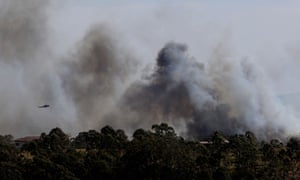An out-of-control bushfire in the New South Wales
Hunter Valley was threatening houses on Wednesday as firefighters
battled a number of fires amid unseasonable heat with Sydney
experiencing its hottest September day on record.
The NSW Rural Fire Service issued an emergency warning for Richmond Vale, near Cessnock on Wednesday morning. The blaze had broken containment lines and burned about 700 hectares of bushland.
Two watch and act warnings were in place for fires at Black Hill near Cessnock and Nabiac, and firefighters were controlling a blaze in Sydney’s northern beaches, near Beacon Hill, after an earlier flare-up.
Before the hot and windy conditions arrived, total fire bans – the first of the season – were declared across swathes of the state.
The RFS declared severe fire danger in four regions including greater Sydney region, greater Hunter, north coast and north western regions.
Strong northwesterly winds were forecast to reach 40-50km/h with gusts up to 70km/h.
Sydney was the hottest capital city in the country on Wednesday, with a maximum forecast temperature of 33 – about 13 degrees above average and the hottest September day since record-keeping began 159 years ago.
At the end of last month the Bureau of Meteorology released its outlook for spring, predicting warmer than average temperatures for the north and southeast of the country and low rainfall for the south west. However higher than average rain was predicted for southeast Queensland and east Gippsland.
Abnormally dry and hot conditions across large parts of the country have prompted warnings about current or upcoming fire seasons.
Last week one house was destroyed and several others damaged in a bushfire south of Darwin. The Northern Territory was predicted to face dangerous fire conditions following the second biggest wet season on record and a short dry season, with land management groups calling for an earlier start to hazard reduction burns.
Western Australia had its driest autumn in five years and is also preparing for a dangerous fire season.
The NSW Rural Fire Service issued an emergency warning for Richmond Vale, near Cessnock on Wednesday morning. The blaze had broken containment lines and burned about 700 hectares of bushland.
Two watch and act warnings were in place for fires at Black Hill near Cessnock and Nabiac, and firefighters were controlling a blaze in Sydney’s northern beaches, near Beacon Hill, after an earlier flare-up.
Before the hot and windy conditions arrived, total fire bans – the first of the season – were declared across swathes of the state.
The RFS declared severe fire danger in four regions including greater Sydney region, greater Hunter, north coast and north western regions.
Strong northwesterly winds were forecast to reach 40-50km/h with gusts up to 70km/h.
Sydney was the hottest capital city in the country on Wednesday, with a maximum forecast temperature of 33 – about 13 degrees above average and the hottest September day since record-keeping began 159 years ago.
At the end of last month the Bureau of Meteorology released its outlook for spring, predicting warmer than average temperatures for the north and southeast of the country and low rainfall for the south west. However higher than average rain was predicted for southeast Queensland and east Gippsland.
Abnormally dry and hot conditions across large parts of the country have prompted warnings about current or upcoming fire seasons.
Last week one house was destroyed and several others damaged in a bushfire south of Darwin. The Northern Territory was predicted to face dangerous fire conditions following the second biggest wet season on record and a short dry season, with land management groups calling for an earlier start to hazard reduction burns.
Western Australia had its driest autumn in five years and is also preparing for a dangerous fire season.

No comments:
Post a Comment